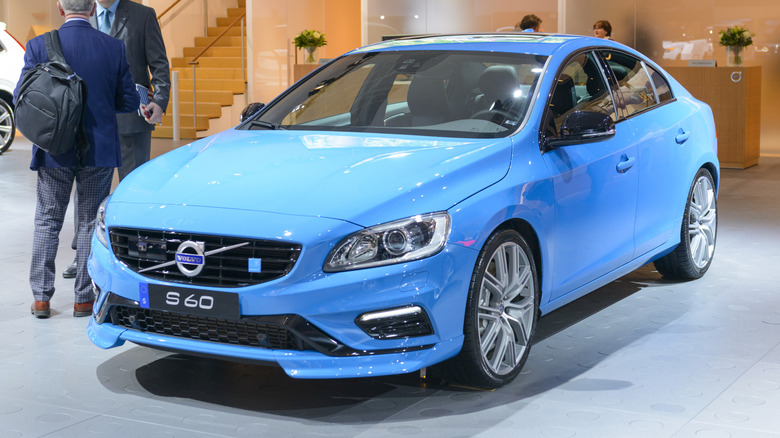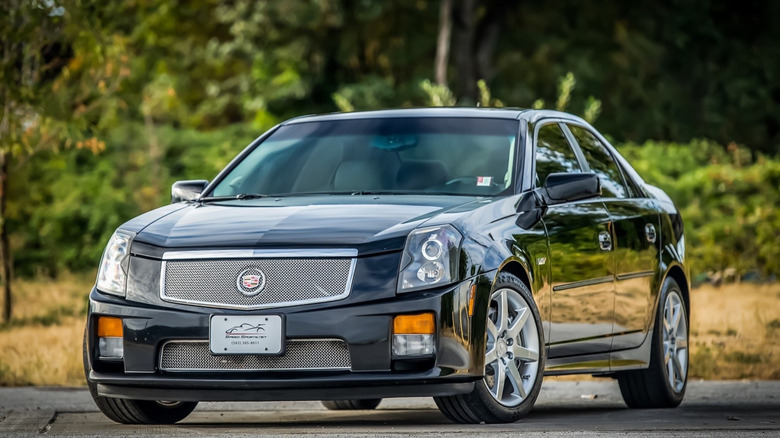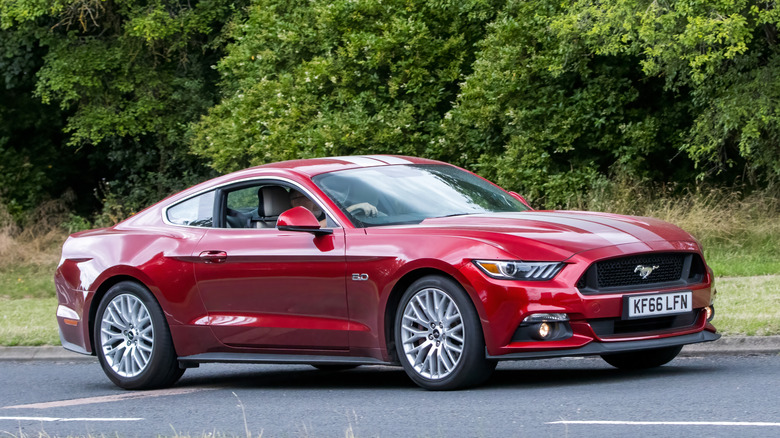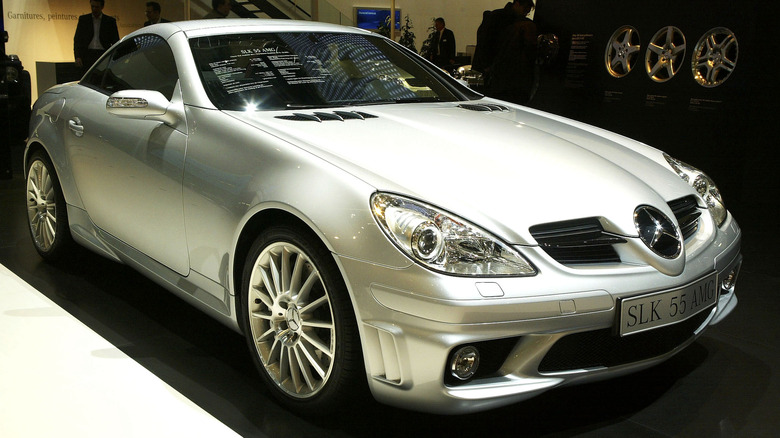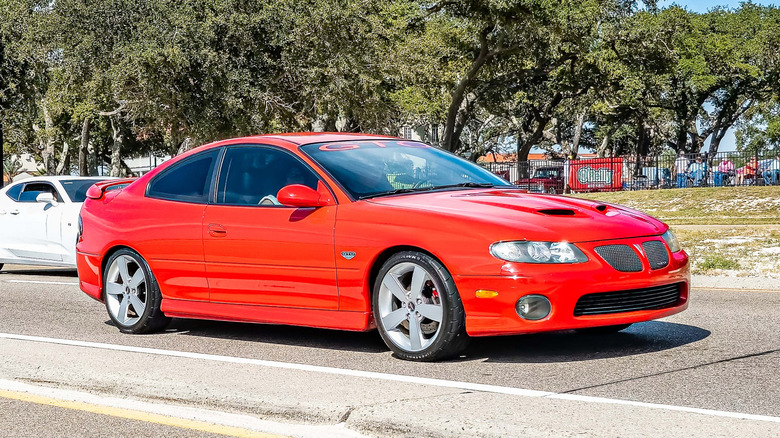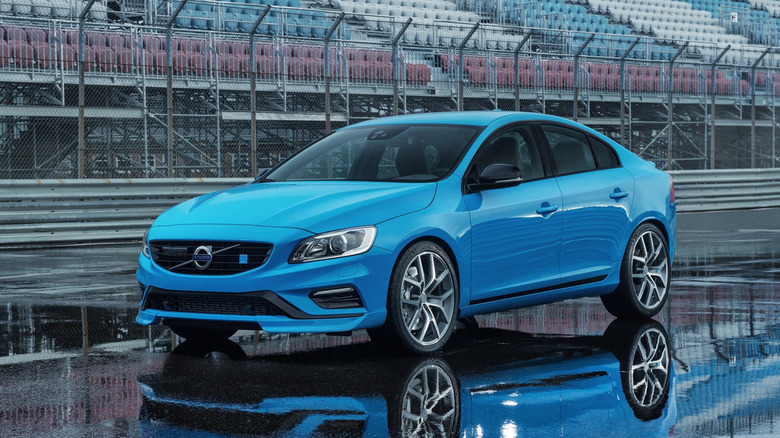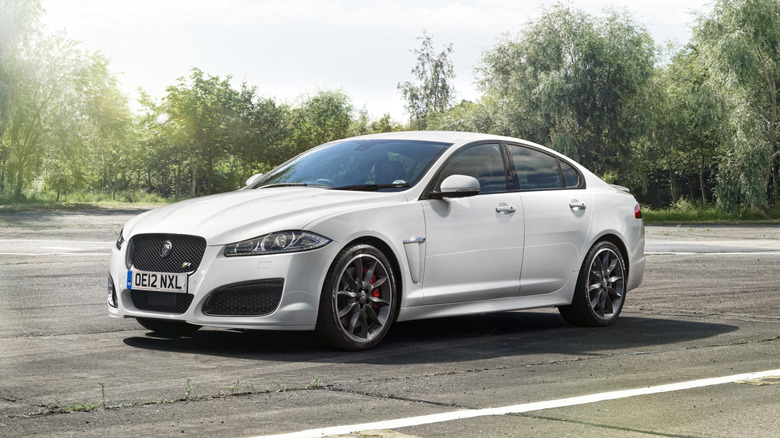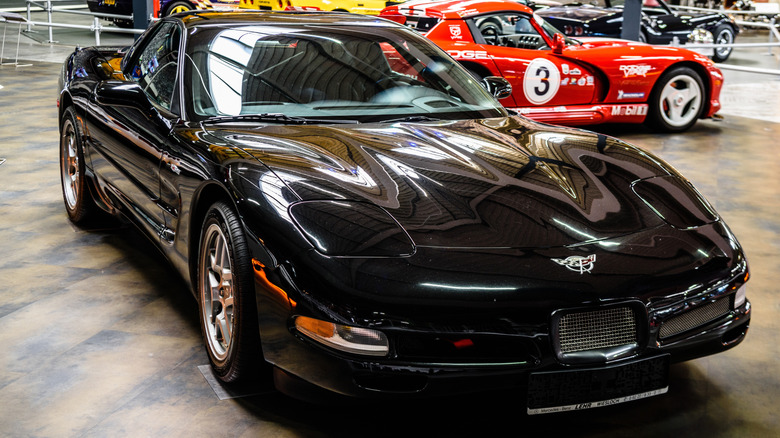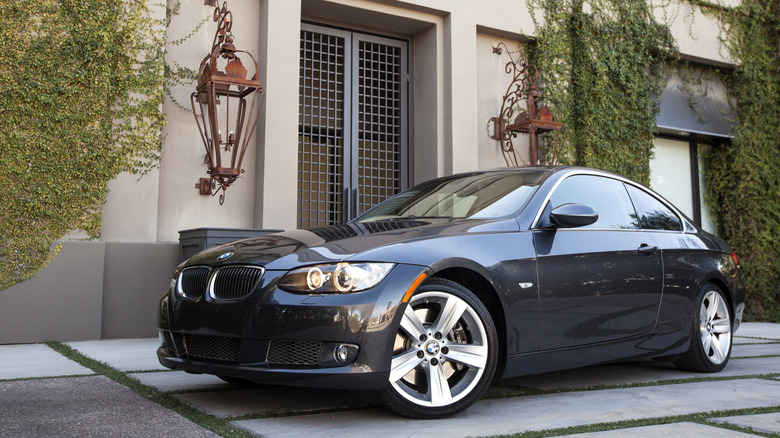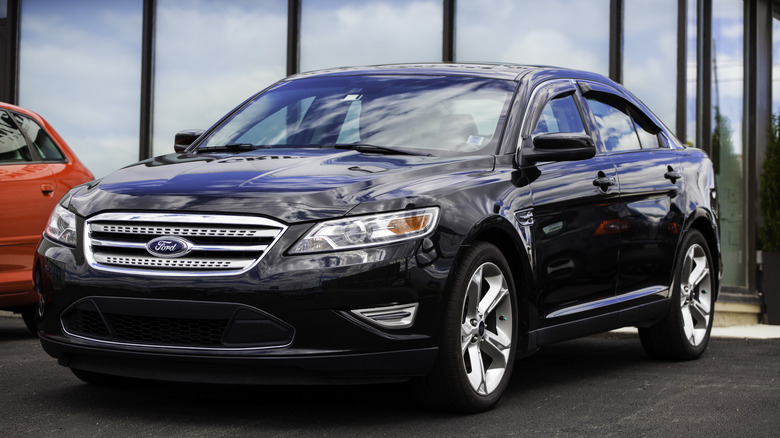10 Cheap Cars With High Horsepower To Consider In 2025
There's a common misconception that in order to get a car with high horsepower, you have to pay a lot of money. While this is often the case, it doesn't really need to be. Some good new cars offer a lot of power for not a lot of money, and even more importantly, there's this wonderful thing in the car world known as depreciation.
Thanks to this wonderful thing, high horsepower cars that once were strictly off limits may now be somewhat affordable. Sports cars, performance sedans, and other cars that were forgotten or misunderstood when they were new. Ones that come from automakers known for bad depreciation. Models that aren't quite as valued by the community as they ought to be. Some have reached the stratosphere in terms of value, but some have remained relatively cheap.
We've covered brand new cars with over 400 hp you can buy in 2025, but now it's time to look through the used market. These cars are not exactly $800 obo like you might see on Craigslist, but they're certainly a lot more affordable than when they were new. As well as their high horsepower figures, they have a lot of other merits as well.
Cadillac CTS-V (first generation)
General Motors has always been one of the best purveyors of cheap high horsepower used cars, and one of the best examples of this is the first generation Cadillac CTS-V. Desperate to shake its reputation as being a favorite of the elderly, Cadillac decided to try beating the Germans at their own game with a performance sedan.
The original CTS-V was like a regular CTS in a lot of ways, but every dial was cranked up a fair bit. Gone was the V6 that was standard fit in the CTS, and in its place came a 5.7-liter naturally aspirated V8 putting out 405 hp. It sent that power to the rear wheels through a six-speed manual transmission, and this was the only CTS-V generation to not offer an automatic.
As well as that LS, the CTS-V was a surprisingly decent handler given its status as an American luxury sedan. It did well on the Nurburgring, the rite of passage for any good-handling performance car. Being a CTS, it's also packed with more than enough features, and its powertrain is highly tunable and reliable (of course it is, it's an LS). This is easily one of the cheapest ways to get into LS V8 ownership, as a good first generation CTS-V can be found for less than $20,000.
Ford Mustang GT (S550)
From 2005 to 2014, the Ford Mustang was basically unchanged under the skin. Sure, the bodywork went through some major changes, but it was still the same old platform and the same old archaic drivetrain setup. That is, until the S550 Mustang came along for model year 2015.
With this generation, everything changed. The tribute band styling was shoved to the side in favor of a sharper, modernized look that didn't forget its heritage. The 5.0-liter Coyote V8 under the hood received some minor updates, but the most significant changes happened to the drivetrain. This was the first regular production Mustang in a long time to have independent rear suspension. The old SVT Cobra had an IRS setup, but the Mustang would switch back to the live axle after that.
As well as that, Ford made some massive improvements to interior quality and features. Today, the S550 Mustang is one of the best modern enthusiast cars if you don't want to pay with a limb or two. You can find a GT for less than $30,000, the powertrain is super reliable and one of the most researched and durable platforms for tuning, and it just looks so good. Plus, with the right tweaks, it can keep up with sports cars on the track.
Mercedes-Benz SLK 55 AMG
Before Mercedes got busy putting TikTok on infotainment systems, as first seen in the latest E-Class, and cheaping out on interior trim, it was busying itself with shenanigans like this. One day, someone at Mercedes had the idea to put a massive 5.4-liter V8 under the hood of a car the size of a Miata. The end result was the gloriously silly SLK 55 AMG.
It looked like a standard SLK for the most part, and it also inherited the neat folding hardtop. The only major giveaway are the quad pipes. Although the engine has barely any room under the hood, it still puts out a handy 360 hp. It has no forced induction, so it's linear power delivery and screaming German V8 soundtrack all the way to the redline. Obviously, the power goes through the rear wheels through the standard fare AMG seven-speed automatic.
Being a Mercedes, it's also full of some pretty desirable features, and thanks to the short wheelbase and relatively low weight, it's a hoot to drive as well. You can find a decent SLK 55 AMG for around $20,000 nowadays, but make sure it has a full service history if you don't want to deal with the very well-known headaches of a badly maintained used AMG Mercedes. Still, the M113 V8 under the hood of the SLK has proven to be much more reliable than some of its contemporaries.
Pontiac GTO
For the revival of one of the most iconic names in GM history, the automaker decided to tap its Australian arm. The Holden Monaro was shipped halfway around the world, its steering wheel was installed on the left-hand side, its badges were swapped out for Pontiac ones, and that's how the storied GTO returned for its fifth generation..
This was right after both the Chevrolet Camaro and the Pontiac Firebird were discontinued, so the timing was spot on. On the outside, the GTO bears a striking resemblance to a three-door Holden Commodore, because that is ostensibly what it is. The formula is actually as simple as it gets. A small block V8 under the hood, RWD, and a limited-slip differential. It's a tale as old as time, and it totally worked.
The GTO offered a more old-fashioned approach to fun driving. Tire smoke, V8 noises, all that good stuff. It was a 5.7-liter LS1 V8 initially, making this one of the many GM muscle cars to offer a member of the LS family. Later GTOs also offered a more powerful 6.0-liter V8. Sadly, despite its long list of good qualities, the Pontiac GTO didn't last very long, much like GM's final attempt to bring Holden to the U.S. Good news though: $20,000 will get you a very solid GTO these days.
Volvo S60 Polestar
From a well-known muscle car to a total wildcard. Volvo tried a couple of times to steal some of the fun from German performance sedans, but it started with the S60 R in the early 2000s. And for the second generation S60, Volvo had another ace up its sleeve: the S60 Polestar. Polestar was Volvo's in-house tuning department, the remnants of which today are known as Cyan Racing, most famous for that wonderful P1800 restomod.
Unlike the S60 R and its turbo five-cylinder, the S60 Polestar used a turbocharged six-cylinder engine, and one that sounds pretty fantastic. AWD came standard, along with some pretty notable exterior changes, including unique wheels and aero. The S60 Polestar had one glaring problem, however.
This was the top of the S60 lineup back then, so you'd think it's an M3 competitor, but actually, it was far from it. With 367 hp, it was more in line with stuff like the 335i. Despite the power disadvantage, it was still good to drive, even if it couldn't set your pants on fire. The S60 Polestar has held its value better than you think, but still, $30,000 or so for a turbocharged, very subtle six-cylinder Volvo is good money. It's also far more interesting than just about any German, and certainly more than its present-day plug-in hybrid namesake.
Jaguar XFR
Let's say you want your performance sedan to have a supercharged V8 and make all sorts of fabulous noises, and the horsepower figure should start with the number five. The Jaguar XFR has got you covered. By this point, Jaguar was serious about gunning for the BMW M5, and the XFR definitely put up a good fight.
Powered by a supercharged 5.0-liter V8, the XFR put out 500 hp, matching the E60 M5 that was still around at the time. Sure, the M5 is great, but the XFR is certainly easier on the eyes than the somewhat controversial E60 M5, and while we will agree that the E60 is aging well, we'd also argue that the XFR is aging much better.
It's also full of some wonderful attention to detail, such as hidden climate vents that only appear on demand, and that iconic Jaguar gear selection dial. The XFR was unable to escape Jaguar depreciation, which means $20,000 or so could net you a fantastic well-kept XFR. Just try to avoid the high mileage ones, and insist on seeing the full service history — this is still a Jaguar, after all. It's also incredibly rare, so you'll need to be patient.
Chevrolet Corvette Z06 (C5)
Similar to the Cadillac CTS-V, the C5 Corvette Z06 is widely regarded as the best and most affordable way to get into Corvette ownership. One important detail about the C5 Corvette is that it was the last Corvette generation — and thus one of the last ever production cars — to have pop-up headlights.
This generation really took on the overall shape that the Corvette became known for throughout the 2000s and 2010s, and it's a fantastic looking thing. The regular C5 is all well and good, but back then the Z06 was the top of the lineup, and it was definitely worth having.
It used the same 5.7-liter V8, but with a few tweaks, it was pushed to well over 400 hp, specifically 411 hp. The C5 Z06 also came only as a coupe, and it only offered a six-speed manual transmission. It's great to drive, it doesn't weigh much at all, and it's reliable. The LS motor's reliability is fabled, and so is its tuning potential, and the other equipment in the C5 Z06 is standard GM fare. The nicest ones are around $30,000, and you can get one for less than that if you're fine with higher miles.
BMW 335i (E9x)
Can't quite swing a E9x M3? How about the lite version? The 335i badge first appeared on a 3 Series for the E9x generation, and it was essentially the highest performance version of the 3 Series outside of the M3. A 3.0-liter turbocharged six-cylinder known as the N54 put out 306 hp to either the rear wheels or all four wheels. On the outside, it was hard to tell you were looking at anything more than a normal sales rep 3 Series, bar the signature dual exhausts.
The N54 is one of a handful of automotive engines that have two distinct reputations. Yes, that's actually possible. On one hand, people often refer to it as the German or European 2JZ due to its surprising tuning potential. People have been able to squeeze horsepower figures in the 500, 600, and even 700 range out of the N54.
While the N54 does have the real 2JZ's tuning capability, it did not inherit one of its other most well-known traits: reliability and durability. The N54 is an infamous problem child in the BMW community, and if you don't maintain it properly, it'll make you cry. Then again, that's the case with most BMW engines. If you do take care of it, the N54 is one of the better modern BMW engines. Still, it handles like a BMW should, and $15,000 to $20,000 gets you a nice one with a good service history. It might be risky, but you'll end up with a pretty solid machine. When it works.
Porsche 911 Turbo (997)
You're probably wondering what the heck a Porsche 911 is doing in a lineup of cheap cars with high horsepower. There really is no such thing as a cheap Porsche 911, and if you do come across such a thing, you should probably avoid it like the plague. However, within the realms of Porsche 911 values, the 997 Turbo is a pretty good bet.
The 997 Turbo is one of the best modern Porsche 911s, and one of the best ways to get into Porsche 911 ownership without paying the — let's be honest — extortionate prices of the newer or the older ones. Most 997 Turbos are automatics, and they're the cheapest ones. The manuals go into the six figures, as they're more desirable, but any other 911 Turbo will set you back a whole lot more — a 993 Turbo would probably require taking out a second mortgage.
Under the engine cover is the 3.8-liter Mezger turbo flat six, one of the most reliable engines ever put in a 911. It puts out 480 hp, and while it can't beat every car in existence using launch control, it's more than fast enough. It's also a Porsche 911, and a great car in all the ways 911s generally are. Plus, it's still modern, so you won't feel like you're driving an antique around town. It's one of the last Porsche 911 Turbos to offer a manual transmission, too. Buy one now, before they become even more expensive.
Ford Taurus SHO
Back to some stuff that is actually cheap. The Ford Taurus SHO is one of the most enigmatic performance cars to ever come out of North America. The first three generations all used a powertrain co-engineered with Yamaha, and they quickly earned the prestigious factory sleeper badge of honor. For the final generation, Ford and Yamaha went their separate ways, and the Blue Oval went solo with the engine.
The Taurus SHO uses a 3.5-liter twin-turbo V6 from the EcoBoost family, putting out 365 hp and 350 lb-ft of torque in factory spec. A six-speed automatic transmission took care of distributing power to all four wheels. The end result is an unassuming full-size American sedan that just happens to be as fast as an older Porsche Boxster.
It gets better, because companies like Livernois Motorsports offer all the hardware you need to push your Taurus SHO well past the 500 hp barrier. That's without upgrading the internals, by the way. If you really feel like taking a risk, you might be able to buy a former police vehicle with the SHO powertrain for a ridiculously low price. Don't worry, though, as even well-kept civilian Taurus SHOs are not that expensive at all.
